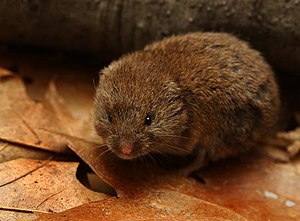Pine vole
| Pine vole | ||||||||||||
|---|---|---|---|---|---|---|---|---|---|---|---|---|

Pine vole ( Microtus pinetorum ) |
||||||||||||
| Systematics | ||||||||||||
|
||||||||||||
| Scientific name | ||||||||||||
| Microtus pinetorum | ||||||||||||
| ( Le Conte , 1830) |
The pine vole ( Microtus pinetorum ) is a rodent in the subfamily of voles found in eastern North America. The species forms the subgenus Pitymys with two Mexican field mice .
features
With a head-trunk length of 63 to 110 mm, a tail length of 17 to 25 mm and a weight of 25 to 38 g, the species is a small representative of the field mice genus. It has rear feet 13 to 19 mm long. The silky-soft fur on the upper side is made up of red-brown to auburn hair. These have black tips on their backs and backs, which creates a darker coat. There is gray fur on the underside. Individual specimens have a different coat color, e.g. B. Albinos . With its cylindrical body, small ears and small eyes, the pine vole is adapted to a burrowing way of life. The diploid chromosome set consists of 62 chromosomes each (2n = 62, F = 62).
Specimens that live in the southeastern part of the range in Georgia and Florida are only about half the size of individuals in other populations. These specimens may represent a species not yet described.
distribution
The western limit of the range extends from eastern Nebraska to eastern Texas . To the north, the pine vole reaches Wisconsin , the central areas of the Great Lakes , smaller Canadian areas south of Toronto and Montreal, and western Maine . In the south the distribution area stretches almost to the Gulf of Mexico and in the east to the Atlantic. The species is absent in much of the Florida peninsula. A demarcated population lives on the Edwards Plateau in central Texas.
The pine vole prefers wooded or bushy regions with loose soil and a pronounced humus layer . It is also found in other habitats such as apple orchards. In contrast to the German name, the species is not restricted to coniferous forests. It is often found in deciduous forests with beech , maple and oak .
The German name and the species epithet in the scientific name, on the other hand, refer to the place where the first specimens were found. As this, John Eatton Le Conte gave a pine forest in Georgia in 1830. It is the same forest created by the Le Contes family, according to a suggestion made by V. Bailey in 1900.
Way of life
The pine vole lives in loose associations in a tunnel system with an associated territory that is about 0.1 hectare in size. The members of the groups, which can consist of several adult animals or females with offspring, show no territorial behavior. The number of individuals in a territory varies between 2 and 15. The species does not hibernate and it can be active at all times of the day. Food includes roots, tubers, seeds, fruits and other parts of plants. When the species eats bark from apple tree roots, it can cause great economic damage. Damage to potatoes , sweet potatoes , peanuts and lily bulbs is also documented. In its hiding place or in other places, the pine vole sets up storage facilities.
Reproduction occurs between February and November, or possibly all year round. In females there are up to four litters with up to five offspring per litter after 20 to 24 days of pregnancy . The young are suckled for 17 to 21 days. In addition to tunnel systems in the ground, cavities in the leaf layer or under fallen trees are also used for nests. The spherical nests are padded with leaves and crushed bark.
threat
The total population of the pine vole is considered stable and there are no threats. The IUCN lists the species as Least Concern .
Individual evidence
- ↑ Don E. Wilson , DeeAnn M. Reeder (Ed.): Mammal Species of the World . A taxonomic and geographic Reference . 3. Edition. 2 volumes. Johns Hopkins University Press, Baltimore MD 2005, ISBN 0-8018-8221-4 (English, Microtus pinetorum ).
- ↑ a b c d e f Don E. Wilson, Thomas E. Lacher Jr., Russell A. Mittermeier (eds.): Handbook of the Mammals of the World. Volume 7 - Rodents II . Lynx Edicions, 2017, ISBN 978-84-16728-04-6 , pp. 335-336 (English).
- ↑ a b c d Larry N. Brown: A Guide to the Mammals of the Southeastern United States . 1997, p. 130-131 ( Microtus pinetorum ).
- ↑ a b c d e f Microtus pinetorum in the endangered species Red List of IUCN 2016. Submitted By: Cassola, F., 2016. Retrieved on 16 June 2020th
